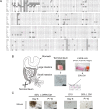WRN conditioned media is sufficient for in vitro propagation of intestinal organoids from large farm and small companion animals
- PMID: 28347989
- PMCID: PMC5450310
- DOI: 10.1242/bio.021717
WRN conditioned media is sufficient for in vitro propagation of intestinal organoids from large farm and small companion animals
Abstract
Recent years have seen significant developments in the ability to continuously propagate organoids derived from intestinal crypts. These advancements have been applied to mouse and human samples providing models for gastrointestinal tissue development and disease. We adapt these methods for the propagation of intestinal organoids (enteroids) from various large farm and small companion (LF/SC) animals, including cat, dog, cow, horse, pig, sheep and chicken. We show that LF/SC enteroids propagate and expand in L-WRN conditioned media containing signaling factors Wnt3a, R-spondin-3, and Noggin (WRN). Multiple successful isolations were achieved for each species, and the growth of LF/SC enteroids was maintained to high passage number. LF/SC enteroids expressed crypt stem cell marker LGR5 and low levels of mesenchymal marker VIM. Labeling with EdU also showed distinct regions of cell proliferation within the enteroids marking crypt-like regions. The ability to grow and maintain LF/SC enteroid cell lines provides additional models for the study of gastrointestinal developmental biology as well as platforms for the study of host-pathogen interactions between intestinal cells and zoonotic enteric pathogens of medical importance.
Keywords: Companion animal; Conditioned media; Crypt; Enteroid; Farm animal; Intestine; Organoid.
© 2017. Published by The Company of Biologists Ltd.
Conflict of interest statement
Competing interestsThe authors declare no competing or financial interests.
Figures




Similar articles
-
Effects of a small molecule R-spondin-1 substitute RS-246204 on a mouse intestinal organoid culture.Oncotarget. 2017 Dec 26;9(5):6356-6368. doi: 10.18632/oncotarget.23721. eCollection 2018 Jan 19. Oncotarget. 2017. PMID: 29464078 Free PMC article.
-
Short-term and long-term human or mouse organoid units generate tissue-engineered small intestine without added signalling molecules.Exp Physiol. 2018 Dec;103(12):1633-1644. doi: 10.1113/EP086990. Epub 2018 Nov 2. Exp Physiol. 2018. PMID: 30232817
-
Optimized Culture Conditions for Improved Growth and Functional Differentiation of Mouse and Human Colon Organoids.Front Immunol. 2021 Feb 12;11:547102. doi: 10.3389/fimmu.2020.547102. eCollection 2020. Front Immunol. 2021. PMID: 33643277 Free PMC article.
-
Farm Animal-derived Models of the Intestinal Epithelium: Recent Advances and Future Applications of Intestinal Organoids.Altern Lab Anim. 2020 Sep-Nov;48(5-6):215-233. doi: 10.1177/0261192920974026. Epub 2020 Dec 18. Altern Lab Anim. 2020. PMID: 33337913 Review.
-
Organoid and Enteroid Modeling of Salmonella Infection.Front Cell Infect Microbiol. 2018 Apr 4;8:102. doi: 10.3389/fcimb.2018.00102. eCollection 2018. Front Cell Infect Microbiol. 2018. PMID: 29670862 Free PMC article. Review.
Cited by
-
Harmonization of Protocols for Multi-Species Organoid Platforms to Study the Intestinal Biology of Toxoplasma gondii and Other Protozoan Infections.Front Cell Infect Microbiol. 2021 Feb 22;10:610368. doi: 10.3389/fcimb.2020.610368. eCollection 2020. Front Cell Infect Microbiol. 2021. PMID: 33692963 Free PMC article.
-
Farm and Companion Animal Organoid Models in Translational Research: A Powerful Tool to Bridge the Gap Between Mice and Humans.Front Med Technol. 2022 May 12;4:895379. doi: 10.3389/fmedt.2022.895379. eCollection 2022. Front Med Technol. 2022. PMID: 35647577 Free PMC article. Review.
-
Bovine Enteroids as an In Vitro Model for Infection with Bovine Coronavirus.Viruses. 2023 Feb 27;15(3):635. doi: 10.3390/v15030635. Viruses. 2023. PMID: 36992344 Free PMC article.
-
Advancing Intestinal Organoid Technology Toward Regenerative Medicine.Cell Mol Gastroenterol Hepatol. 2017 Nov 2;5(1):51-60. doi: 10.1016/j.jcmgh.2017.10.006. eCollection 2018. Cell Mol Gastroenterol Hepatol. 2017. PMID: 29204508 Free PMC article. Review.
-
Apical-out intestinal organoids as an alternative model for evaluating deoxynivalenol toxicity and Lactobacillus detoxification in bovine.Sci Rep. 2024 Dec 28;14(1):31373. doi: 10.1038/s41598-024-82928-0. Sci Rep. 2024. PMID: 39733018 Free PMC article.
References
-
- Aoki R., Shoshkes-Carmel M., Gao N., Shin S., May C. L., Golson M. L., Zahm A. M., Ray M., Wiser C. L., Wright C. V. E. et al. (2016). Foxl1-expressing mesenchymal cells constitute the intestinal stem cell niche. Cell Mol. Gastroenterol. Hepatol. 2, 175-188. 10.1016/j.jcmgh.2015.12.004 - DOI - PMC - PubMed
-
- Barker N., Huch M., Kujala P., van de Wetering M., Snippert H. J., van Es J. H., Sato T., Stange D. E., Begthel H., van den Born M. et al. (2010). Lgr5(+ve) stem cells drive self-renewal in the stomach and build long-lived gastric units in vitro. Cell Stem Cell 6, 25-36. 10.1016/j.stem.2009.11.013 - DOI - PubMed
Grants and funding
LinkOut - more resources
Full Text Sources
Other Literature Sources
Miscellaneous

